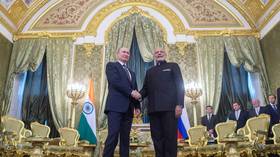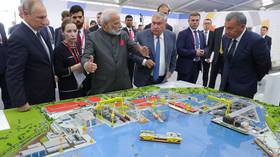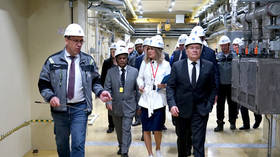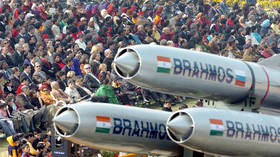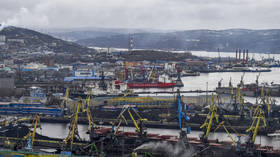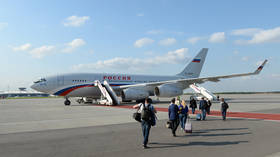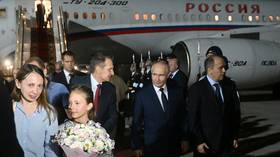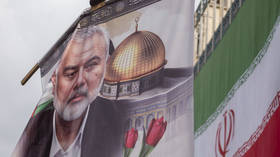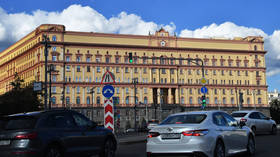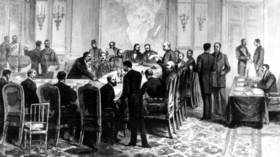Oil, nuclear power, and sustainable trade: Putin-Modi summit’s key outcomes
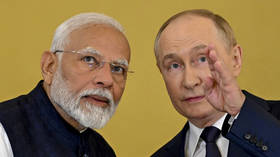
Prime Minister Narendra Modi’s two-day visit to Moscow for the 22nd annual bilateral summit between India and Russia has resulted in a joint statement covering areas such as energy and defense cooperation, trade, space, and connectivity.
Moscow and New Delhi signed nine separate agreements, including on promoting cross-border investments, on trade and investments in the Russian Far East through 2029, and cooperation on climate change and low-carbon development.
Russia was chosen as the country for Modi’s first bilateral visit after securing a third consecutive term in office. It was also his first trip to the country since the outbreak of hostilities in Ukraine in 2022.
Efforts for peace
While the bilateral talks were focused mainly on economic cooperation between the two nations, the leaders had a “frank” conversation about the Ukraine conflict and geopolitical situation globally. Ahead of closed-door talks at the Kremlin, and a day after spending several hours at Russian President Vladimir Putin’s official residence in Moscow’s suburbs, Modi stated that the solution to any conflict “cannot be found on the battlefield” and that the death of civilians, particularly children, “makes the heart explode.”
The Russian leader thanked Modi for the attention he is paying to the world’s “most pressing problems, including trying to find some ways to resolve the Ukrainian crisis.”
The Indian prime minister noted that Putin was “very open in expressing his opinions” on the Ukraine conflict and stated that “very interesting ideas” and “completely new views” emerged from their talks. “And I can say that after listening to President Putin, I have hope,” Modi added.
The friendly interactions between the two leaders during the course of Modi’s stay in the Russian capital annoyed Kiev and Washington, with the latter making repeated comments on “concerns” it has over New Delhi’s close ties with Moscow.
Bilateral trade
Russia and India have set a goal of reaching $100 billion in bilateral trade by 2030. Previously, the leaders had a target of $30 billion by 2025, which was surpassed by a significant margin during the last financial year.
In 2023, bilateral trade stood at $65 billion, having been driven by a surge in oil purchases. However, Indian exports to Russia stood at less than $5 billion, and both countries emphasized the importance of diversifying trade to make it more sustainable going forward.
According to Vladimir Putin’s top economic adviser Maksim Oreshkin, suitable payment mechanisms also featured in the leaders’ discussions. Secureinfrastructure for ensuring sustainable trade and investments “is one of the important issues” for the two nations, he said.
According to Indian Foreign Secretary Vinay Mohan Kwatra, the $100 billion target for bilateral trade is “first of all, an expression by the two leaders of the ambition that they have set for the larger economic relationship.” It is also a “very clear direction to the two systems” to boost efforts to diversify the trade basket.
Energy cooperation
Russia has emerged as India’s key supplier of oil after the Ukraine conflict escalated in 2022, despite open criticism from New Delhi’s Western partners.
Cheaper crude oil from Russia has also facilitated India’s value-added petroleum product exports, contributing to a 54.78% increase in exports of petroleum products during April-January FY23. Countries such as Brazil, Israel, the Netherlands, and South Africa have witnessed substantial growth in consumption of Indian exports, with petroleum products playing a crucial role. In their joint statement, the two countries said they had “agreed to explore new long term contracts.”
The two sides also agreed to explore the possibility for further increasing the supply of coking coal and the opportunities for exporting anthracite coal from Russia to India.
Commenting on the energy cooperation talks, Kwatra noted that India’s oil imports from Russia are not just an important feature of bilateral ties, but also “a very crucial segment when it comes to the energy security of India.”
India has not only imported Russian crude, but invested in the Russian energy ecosystem, including the Sakhalin-1 oil project. “The two leaders, when they spoke of cooperation in this sector, they did focus on how exactly to strengthen that partnership. In the similar way, how exactly India, including in particular through the government-to-government route, could also build partnership with Rosneft and other energy entities,” the Indian diplomat said.
Nuclear power
Moscow and New Delhi also discussed expanding cooperation in the nuclear energy field. Russia has so far been the only foreign country involved in constructing nuclear power generating capacity in India.
Russian nuclear technology has been instrumental in the construction of the 6000 MW Kudankulam NPP in the southern part of the country. The plant’s first two units, each with a capacity of 1000 MW, entered service in 2013 and 2016, respectively. Two more units are nearing completion, and the construction of two others began in 2021. The project was extensively discussed by the leaders.
The joint statement also notes that the two sides agreed to continue technical discussions on a potential new nuclear power plant of Russian design with a more advanced VVER-1200 reactor (this model of water-cooled power reactor is supplied to nuclear power plants in China, Bangladesh, Belarus and other countries).
Moscow and New Delhi also discussed localizing manufacturing and joint production of nuclear power plant components, as well as operating projects in third countries. India is already participating in Rosatom’s project for construction of a nuclear power plant in Bangladesh.
During a tour of the Atom Pavilion in Moscow, the two leaders saw details of a range of different nuclear energy technologies and projects, including nuclear-powered ice breakers and floating nuclear power plants. Such plants, according to Putin, could eventually “replace the oil produced around the world.” Rosatom Director General Alexei Likhachev told Modi that Russia could offer small nuclear power stations to India with “very deep localization,” TASS reported.
Defence
The joint statement underscores that military-technical cooperation between the two countries has traditionally been the central pillar of ties. The two sides agreed to hold the next round of talks by the Intergovernmental Commission on Military and Military Technical Cooperation (IRIGC-M&MTC) which oversees strategic and defense engagement in Moscow, in the second half of this year.
Notably, the statement mentions the changing nature of defense cooperation – in what seems like a “response” to allegations that India has been “drifting away” from Russia as its largest defense partner in terms of volumes of supplies. “Responding to India’s quest for self-sufficiency, the partnership is reorienting presently to joint research and development, co-development and joint production of advanced defence technology and systems,” the statement says, adding that both nations pledge to “maintain the momentum” of joint military cooperation activities.
Ahead of the summit, Rosoboronexport, Russia’s defense-export agency and part of state-owned Rostec defense corporation, announced setting up the production of 3VBM17 ‘Mango’ rounds in the South Asian country under the ‘Make In India’ initiative. The 125-mm projectiles are designed for firing from the main gun of the T-72 and T-90 tanks deployed by India’s military.
Rostec also announced that another Indo-Russian joint venture produced and delivered 35,000 AK-203 Kalashnikov rifles to the Indian Ministry of Defense. The joint venture was set up in Korwa Ordnance Factory in Amethi, Uttar Pradesh, in 2019.
Russia remains the largest defense supplier to India, though the South Asian nation has been diversifying its sources of military imports and technological partnerships, according to the Stockholm International Peace Research Institute (SIPRI). BrahMos missiles, co-developed by India and Russia, have emerged as a mainstay in the Indian Armed Forces, as well as a key military export item for New Delhi.
Early this year, a batch of BrahMos missiles worth $375 million was supplied to the Philippines. Other nations – including Thailand, Vietnam, Saudi Arabia, and Indonesia – have reportedly expressed interest in acquiring the supersonic cruise missiles.
Russia has also recently approved the draft of the Reciprocal Exchange of Logistics Agreement. It is a mutual defense logistics pact that will ensure joint inter-operability between the Russian and Indian armed forces during military exercises, as well as in case of deployment for humanitarian and disaster relief missions.
“Agreements of this kind expand the geographic opportunities for peacetime operations for all participating parties. Currently, this is less relevant for Russia since its main efforts are focused on the military operation in Ukraine, but after the conflict ends, this agreement will be useful,” Alexey Kupriyanov, head of the Center of the Indo-Pacific Region of the Primakov National Research Institute of World Economy and International Relations (IMEMO), told RT.
“It is possible that the provisions of this agreement will apply in the case of joint exercises in Arctic territories and waters of the Arctic Ocean. From the perspective of Indian military elites and the expert community, this is important because Delhi is concerned about increased Chinese activity in polar regions,” the expert added.
Connectivity
The two countries also discussed the progress achieved in opening up two vital routes that could boost trade and economic engagement by reducing time and the cost of logistics and providing a secure alternative to existing maritime routes such as the Suez Canal. The two countries are working on implementing the Chennai-Vladivostok (Eastern Maritime) Corridor and the International North-South Transport Corridor via Iran, as well as using the potential of the Northern Sea Route in the Arctic.
“The Sides share approaches on building a new architecture of stable and efficient transport corridors, and pay close attention to the development of promising production and marketing chains in Eurasia, including for the purpose of implementing the idea of a Greater Eurasian space,” the statement noted.
It emphasized, in what seems to be a veiled reference to the Chinese Road and Belt Initiative rejected by India, that the new routes will be developed following several principles – “transparency, broad participation, local priorities, financial sustainability and respect for sovereignty and territorial integrity of all nations.”
Logistics and payment settlement issues remain the key obstacles for exporters in both countries. However, the new trade routes will not only boost bilateral commerce between India and Russia, but also provide New Delhi with greater access to the markets of Central Asia, Europe, and the vital Arctic Region, where Indian interests are growing.
